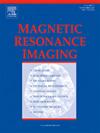加速DESPOT1与可变参数的3D T1脑映射。
IF 2
4区 医学
Q2 RADIOLOGY, NUCLEAR MEDICINE & MEDICAL IMAGING
引用次数: 0
摘要
目的:驱动平衡单脉冲观察T1 (DESPOT1)是临床三维T1脑成像的可靠技术。然而,其固定的重复时间(TR)和带宽(BW)以及估计T1的线性建模导致了低效的成像协议。为了提高扫描效率,加快图像采集速度,提出了一种可变DESPOT1 (vDESPOT1)采集和建模策略。方法:vDESPOT1采用SPGR采集,优化TRs、BWs和fa的组合,结合基于字典的重建,实现更快的采集和更高效的T1映射。将提出的vDESPOT1方法与幻影和10个脑健康受试者的DESPOT1和反转恢复自旋回波(IR-SE)进行比较。结果表明,与传统的DESPOT1相比,扫描时间减少了约40% %,在保持准确性和T1NR的同时,可以实现更快的3D脑T1映射。与传统的线性回归相比,vDESPOT1预计算字典的计算效率降低了约50倍的重建时间。当使用vDESPOT1时,可变BW可以在不显著影响T1信噪比的情况下提高扫描效率。结论:这些时间的改进使得vDESPOT1在动态和高场MRI应用中特别有价值,例如热治疗监测,DCE-MRI中的药代动力学分析,以及易于运动的解剖结构(包括心脏,肝脏和肺部)的成像。本文章由计算机程序翻译,如有差异,请以英文原文为准。
Accelerated DESPOT1 with variable parameters for 3D T1 brain mapping
Purpose
Driven equilibrium single pulse observation of T1 (DESPOT1) is a reliable technique for clinical 3D T1 brain mapping. However, its fixed repetition time (TR) and bandwidth (BW) and its linear modeling to estimate T1 conveys to an inefficient imaging protocol. We propose a variable DESPOT1 (vDESPOT1) acquisition and modeling strategy to improve scan efficiency and to accelerate image acquisition.
Methods
vDESPOT1 uses SPGR acquisitions with optimized combinations of TRs, BWs, and FAs, coupled with dictionary-based reconstruction to achieve faster acquisition and more efficient T1 mapping. The proposed vDESPOT1 method was compared to DESPOT1 and inversion recovery spin echo (IR-SE) in phantom and in ten brain healthy subjects.
Results
Results demonstrate a reduction in scan time of approximately 40 %, allowing faster 3D brain T1 mapping while maintaining accuracy and T1NR in comparison to conventional DESPOT1. Also, the computational efficiency of a pre-computed dictionary of vDESPOT1 reduces the reconstruction time by ∼50× in comparison linear regression of conventional DESPOT1. Variable BW can enhance scan efficiency without significantly affecting the SNR for T1 when using vDESPOT1.
Conclusion
These time improvements make vDESPOT1 particularly valuable for dynamic and high-field MRI applications, such as thermal therapy monitoring, pharmacokinetic analysis in DCE-MRI, and imaging in anatomies prone to motion, including the heart, liver, and lungs.
求助全文
通过发布文献求助,成功后即可免费获取论文全文。
去求助
来源期刊

Magnetic resonance imaging
医学-核医学
CiteScore
4.70
自引率
4.00%
发文量
194
审稿时长
83 days
期刊介绍:
Magnetic Resonance Imaging (MRI) is the first international multidisciplinary journal encompassing physical, life, and clinical science investigations as they relate to the development and use of magnetic resonance imaging. MRI is dedicated to both basic research, technological innovation and applications, providing a single forum for communication among radiologists, physicists, chemists, biochemists, biologists, engineers, internists, pathologists, physiologists, computer scientists, and mathematicians.
 求助内容:
求助内容: 应助结果提醒方式:
应助结果提醒方式:


